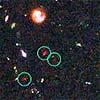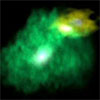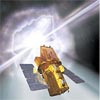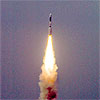|
Sunday:
September 26, 2004 | |
0001 GMT |
 |
Cape prays as Jeanne hits Florida
Already battered by Hurricane Frances earlier this month, Kennedy Space Center and Cape Canaveral are bracing for another tropical blast. The spaceport has been closed as powerful Hurricane Jeanne tracks toward a Sunday morning landfall along Florida's east coast.
 FULL STORY FULL STORY
 |  |

|
 |
Chandra watches a glowing cloud dubbed the Mouse
Astronomers have used an X-ray image to make the first detailed study of the behavior of high-energy particles around a fast moving pulsar. The image, from NASA's Chandra X-ray Observatory, shows the shock wave created as a pulsar plows supersonically through interstellar space.
 FULL STORY FULL STORY
 |  |

|
 |
NASA: Increased thinning of West Antarctic glaciers
Glaciers in West Antarctica are shrinking at a rate substantially higher than observed in the 1990s. They are losing 60 percent more ice into the Amundsen Sea than they accumulate from inland snowfall.
 FULL STORY FULL STORY
 |  |

|
 |
OTHER HEADLINES Additional stories today
|
 |
NASA is showing in a theater near you -- As moviegoers wait in line to purchase tickets at Regal Entertainment Group (REG) theatres across the country, they will also get a lesson in science, technology, engineering and mathematics, as NASA becomes part of the movie preview line up. REG theatres include Regal Cinemas, United Artists
Theatres and Edwards Theatres nationwide.
|
 |
|
Saturday:
September 25, 2004 | |
0353 GMT |
 |
Hubble's view approaches the dawn of galaxies
Detailed analyses of mankind's deepest optical view of the universe by several expert teams have at last identified what may turn out to be some of the earliest star-forming galaxies. Astronomers are now debating whether the hottest stars in these early galaxies may have provided enough radiation to "lift a curtain" of cold, primordial hydrogen that cooled after the big bang.
 FULL STORY FULL STORY
 |  |

|
 |
|
Friday:
September 24, 2004 | |
0112 GMT |
 |
Here comes Jeanne
Kennedy Space Center and Cape Canaveral are within the target of yet another powerful hurricane as Jeanne churns toward a potential direct hit to the spaceport on Sunday with 120 mph winds.
 FULL STORY FULL STORY
 |  |

|
 |
Massive merger of galaxies is most powerful on record
An international team of scientists announced Thursday they observed a nearby head-on collision of two galaxy clusters. The clusters smashed together thousands of galaxies and trillions of stars. It is one of the most powerful events ever witnessed. Such collisions are second only to the Big Bang in total energy output.
 FULL STORY FULL STORY
 |  |

|
 |

Additional coverage for subscribers:
 AUDIO:
LISTEN TO NEWS BRIEFING ANNOUNCING THIS DISCOVERY QT AUDIO:
LISTEN TO NEWS BRIEFING ANNOUNCING THIS DISCOVERY QT
 SUBSCRIBE NOW SUBSCRIBE NOW

|
Genesis team ships first recovered sample
The Genesis team has shipped its first scientific sample from the mission's specially constructed cleanroom at the U.S. Army Proving Ground in Dugway, Utah. The sample, containing what are known as "lid foils," was attached to the interior lid of the Genesis sample return capsule.
 FULL STORY FULL STORY
 |  |

|
 |
OTHER HEADLINES Additional stories today
|
 |
AirTV signs with Arianespace -- AirTV has signed a launch services agreement with Arianespace to orbit its first broadband spacecraft, which will deliver a new level of in-flight entertainment and connectivity for airlines worldwide.
|
 |
|
Thursday:
September 23, 2004 | |
0435 GMT |
 |
Space telescope will watch powerful cosmic blasts
An agile gamma-ray observatory with a focus on the most intense explosions in the cosmos -- cataclysmic blasts occurring every day throughout the universe that seemingly foreshadow the creation of black holes -- will be launched into space October 26.
 FULL STORY FULL STORY
 |  |

|
 |
High energy mystery lurks at the galactic center
A mystery lurking at the center of our own Milky Way galaxy -- an object radiating high-energy gamma rays -- has been detected by a team of astronomers. The research was carried out using an array of four telescopes in Africa.
 FULL STORY FULL STORY
 |  |

|
 |
OTHER HEADLINES Additional stories today
|
 |
X-43A captive carry flight reset -- The captive carry flight of NASA's X-43A hypersonic research aircraft originally scheduled earlier this month has been reset for Sept. 27. The captive carry flight is a "dress rehearsal" for the planned free flight later this fall.

PanAmSat selects Sea Launch for Galaxy 16 mission -- Sea Launch has been selected to launch PanAmSat's Galaxy 16 communication satellite. The agreement provides for Sea Launch to lift the 4,700-kg spacecraft to geosynchronous transfer orbit in 2006.
|
 |
|
Wednesday:
September 22, 2004 | |
0142 GMT |
 |
Mars rovers renewed
As NASA's Spirit and Opportunity rovers resumed reliable contact with Earth, after a period when Mars passed nearly behind the Sun, the space agency extended funding for an additional six months of rover operations, as long as they keep working.
 FULL STORY FULL STORY
 MARS ROVER ARCHIVE MARS ROVER ARCHIVE
 |  |

|
 |
Sugar in space provides clue to origin of life
Astronomers have discovered a frigid reservoir of simple sugar molecules in a cloud of gas and dust some 26,000 light-years away, near the center of our Milky Way Galaxy. The discovery suggests how the molecular building blocks necessary for the creation of life could first form in interstellar space.
 FULL STORY FULL STORY
 |  |

|
 |
What Genesis solar particles can tell us
The recent crash of NASA's Genesis space probe may have looked like bad news for scientists, but its cargo of particles captured from the sun should still yield useful information, according to Qing-Zhu Yin, a planetary scientist at University of California-Davis.
 FULL STORY FULL STORY
 |  |

|
 |
|
Tuesday:
September 21, 2004 | |
0331 GMT |
 |
India launches educational satellite using GSLV rocket
Following two developmental test launches, India's GSLV rocket successfully flew its first operational mission Monday, boosting into orbit a communications satellite that will be used for interactive educational services in remote locations.
 FULL STORY FULL STORY
 |  |

|
 |
A new clue from Mars?
Recent analyses of ESA's Mars Express data reveal that concentrations of water vapour and methane in the atmosphere of Mars significantly overlap. This result gives a boost to understanding of geological and atmospheric processes on Mars, and provides important new hints to evaluate the hypothesis of life present on the Red Planet.
 FULL STORY FULL STORY
 |  |

|
 |
NASA picks contractor for first Prometheus mission
NASA's Jet Propulsion Laboratory selected Northrop Grumman Space Technology as the contractor for co-designing the proposed Prometheus Jupiter Icy Moons Orbiter (JIMO) spacecraft. The contract award is for approximately $400 million, covering work through mid-2008.
 FULL STORY FULL STORY
 |  |

|
 |
OTHER HEADLINES Additional stories today
|
 |
Alcatel signs a new contract for Express AM33 and AM44 payloads -- Alcatel has announced the signature of a new contract with the Russian Satellite Communications Company to develop and deliver the payloads for the Express AM33 and AM44 communications satellites.
|
 |
NEWSWIRE Links to news across the internet
|
 |
Boeing countersues Lockheed in rocket launch case -- (Reuters) Boeing Co. has filed a counter lawsuit against Lockheed Martin Corp. seeking unspecified damages for what it called a "smear campaign" in an alleged corporate espionage case that has already cost Boeing about $1 billion in government orders.

Boeing goes on the offensive against Lockheed -- (Financial Times) Boeing has gone on the offensive in its ongoing legal battle with Lockheed Martin by accusing the aerospace company of seeking to "inflict reputational and competitive harm against Boeing", by making false statements about a controversial satellite launch contract it lost in 1998.
|
 |
|
Monday:
September 20, 2004 | |
0111 GMT |
 |
Foreseeing the Sun's fate
For more than 400 years, astronomers both professional and amateur have taken a special interest in observing Mira stars, a class of variable red giants famous for pulsations that last for 80-1,000 days and cause their apparent brightness to vary by a factor of ten times or more during a cycle.
 FULL STORY FULL STORY
 |  |

|
 |
Huygens test successful
The European Space Agency's Huygens probe, now orbiting Saturn onboard the Cassini spacecraft, is in good health and successfully passed its fifteenth 'In-Flight Checkout' last week. This test procedure was the last but one planned before separation of the Huygens probe from Cassini in December.
 FULL STORY FULL STORY
 |  |

|
 |



